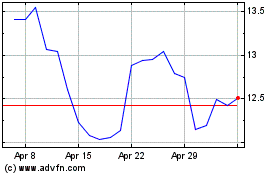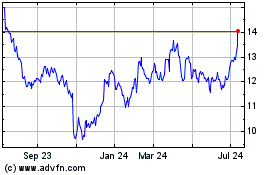Donald Trump, GM, Ford and Made-in-Mexico Car
January 03 2017 - 2:28PM
Dow Jones News
By John D. Stoll
Donald Trump on Tuesday stepped up criticism of the auto
industry's use of Mexican factories as a way to lower manufacturing
costs, ripping into General Motors Co.'s decision to import a
modest number of Chevy hatchbacks from Mexico to U.S. dealerships.
Hours later, Ford Motor Co. said it was altering its own small-car
production plans for Mexico after facing the president-elect's
barbs for more than a year.
Here is a rundown of how the two biggest auto makers fit into
wider concern about the future of the American car as supply chains
become more global and a look at how big a task it would be to
reverse the Made-in-Mexico car trend:
How is Ford changing its plans, and why is GM involved?
Ford still will shift its Focus production to Mexico as American
demand for compacts and sedans fades, but it will use existing
plants there instead of building a new $1.6 billion factory that
has been in the works for more than a year. The company said this
move will free up $700 million to create 700 jobs at a plant in
Michigan that needs to be retooled for electrified versions of SUVs
and other vehicles. This comes shortly after Ford decided not to
move production of a small Lincoln SUV from Kentucky to Mexico.
GM and smaller rival Fiat Chrysler Automobiles NV also have
ambitious plans for Mexico production, but neither have gotten the
same level of attention from Mr. Trump that Ford has received. That
changed Tuesday when Mr. Trump said GM should be paying taxes for
the Chevrolet Cruze hatchbacks that are made in Mexico and sold in
the U.S. GM has built a more conventional version of the Cruze in
Ohio for several years, but it is currently cutting jobs at that
factory because of weak demand for that version.
Will Ford's decision to appear willing to work with Mr. Trump
affect GM, others?
The immediate focus will be on whether GM chooses to retool that
Ohio plant to make hatchbacks, which are more popular than
bread-and-butter compact cars and a potential winner for Chevy's
lineup. The bigger question is whether the wave of auto makers
migrating to Mexico can be stopped and the trend to put an
increasing amount of foreign parts in American cars can be
stemmed.
What about the supply of parts? Even if cars are assembled in
Ohio or Michigan or another state, components come from all
over.
The fact is, American cars are becoming less American. The
model-year 2017 Cruze, for instance, relies on the U.S. or Canada
for only 44% of its parts content, compared with 60% in 2012,
according to the National Highway Traffic Safety Administration,
which compiles data annually on where the individual parts content
of vehicles originate. NHTSA only provides data for combined Canada
and U.S. production.
According to preliminary data provided by NHTSA, 51% of the
content on 2017 model-year light vehicles built by Ford, GM and
Fiat Chrysler Automobiles NV came from the U.S. or Canada, down
from 53% in the prior-year model. The United Auto Workers, in fact,
has defended Mr. Trump's trade views because union officials say
free-trade deals like Nafta have encouraged offshoring of steering
wheels, seats, axles, engines and thousands of other parts for
decades.
Could Mr. Trump's recent moves fortify the American car
industry?
Auto makers are expected to boost reliance on foreign sources of
parts because global parts supply chains are increasingly woven
together. And, while Ford's decision will reduce the amount of
physical factories global auto makers have in Mexico, it won't
change the fact that Mr. Trump's administration is entering a
four-year stretch where Mexican vehicle assembly will skyrocket if
nothing else changes because car companies appreciate the low wages
in Mexico and rely on the nation's arsenal of free-trade deals with
countries all over the world to keep Mexico as an attractive export
base.
In 2016, there were 17 assembly plants in Mexico, and by 2020
there will be at least 20 even after the Ford move. Nissan Motor
Co. and Daimler AG are constructing a plant together in Mexico, and
others -- including Volkswagen's Audi AG Honda Motor Co. and Kia
Motors Corp. -- have or are in the process of adding plants
there.
Auto makers produced 3.4 million vehicles in Mexico in 2016 and
that figure is expected to grow 50% to 5.1 million by the end of
the decade, taking Mexico's percentage of North American vehicle
light vehicles from 19.4% today to 27.9% in 2020, WardsAuto.com
estimates. The U.S. percentage is expected to fall from 67.2% to
61.9%, with production slipping 6% to 11.2 million. About 45% of
Mexico's growth will be driven by added capacity by Detroit's Big
Three auto makers, according to WardsAuto.com.
Write to John D. Stoll at john.stoll@wsj.com
(END) Dow Jones Newswires
January 03, 2017 14:13 ET (19:13 GMT)
Copyright (c) 2017 Dow Jones & Company, Inc.
Ford Motor (NYSE:F)
Historical Stock Chart
From Mar 2024 to Apr 2024

Ford Motor (NYSE:F)
Historical Stock Chart
From Apr 2023 to Apr 2024
